This is an old revision of this page, as edited by Badagnani (talk | contribs) at 19:52, 11 June 2008 (rv repeated blanking (vandalism)). The present address (URL) is a permanent link to this revision, which may differ significantly from the current revision.
Revision as of 19:52, 11 June 2008 by Badagnani (talk | contribs) (rv repeated blanking (vandalism))(diff) ← Previous revision | Latest revision (diff) | Newer revision → (diff)| This article needs additional citations for verification. Please help improve this article by adding citations to reliable sources. Unsourced material may be challenged and removed. Find sources: "Korean cuisine" – news · newspapers · books · scholar · JSTOR (August 2007) (Learn how and when to remove this message) |

Korean cuisine is based on the traditional foods and preparation techniques of Korea. From the complex Korean royal court cuisine to regional specialties and modern fusion cuisine, their ingredients and preparation are richly varied. Since the late 20th century many dishes have become internationally popular. Korean cuisine can differ greatly in its many provinces.
Korean cuisine varies seasonally. During winter, traditional food usually relies on kimchi and other pickled vegetables preserved in big ceramic containers stored underground in outdoor courtyards. Food preparation is generally very labor-intensive. The cuisine is largely based on rice, noodles, tofu, vegetables, and meats. Traditional Korean meals are noted for the number of side dishes (banchan) that accompany the ubiquitous steam-cooked short-grain rice and soup. Every meal is accompanied by numerous banchan. Kimchi is a fermented, spicy vegetable dish usually made of baechu (Napa cabbage), mu (daikon), or cucumber. At least one type of kimchi is served as banchan at virtually every meal, year-round. It is also a common ingredient in other Korean recipes.
Korean cuisine usually involves heavy seasoning with sesame oil, doenjang (fermented soybean paste), soy sauce, salt, garlic, ginger and gochujang (red chili paste). Korea is the largest consumer of garlic, ahead of the rest of Asia (particularly China and Thailand, excluding Japan) and the Northern Mediterranean (mainly Spain, Italy, and Greece).
History
Much of Korean history is shrouded in myth and legend, especially during the foundation of the country. As such much of the history of cuisine is based on the same sort of myths and legends. This basis of culture however, has been extremely important to the evolution of the cuisine found in the country today.
Antiquity
Early records speak of the agrarian nature of Korean culture. For example in the foundation of one of the early kingdoms, Gojoseon, is recorded in the Myth of Dangun. The myth speaks of Hwanung, the offspring of the Korean god who fathers a son with a bear that had been transformed into a woman. In order for the bear to transform into a woman, the bear is required to eat garlic and mugwort for one hundred days, which acknowledges the importance of foods having medicinal purposes in early Korean culture. The offspring between Hwanung and the transformed bear, Ungnyeo was named Dangun, who was given the ability to control the elements necessary for agriculture, wind, rain, and clouds. It is this myth that illustrates the agrarian nature of the Gojoseon society.
Archaeology has shown a number of other characteristics of this period as well. Rock drawings in the southeastern portion of the Korean peninsula at Pan'guade illustrate whale and marine-life alluding to the importance of fishing. Additionally, mounds of shells, and mounds of bones from wild boar and deer] give some insight to the diet of early Koreans. Along with these piles have been found evidence of shared technology from China, including farming implements such as ploughshares, and sickles. The existence of sickles illustrates that at this time rice was harvested in bunches, not by individual stalks, illustrating sophisticated thought in agriculture.
Three Kingdoms period - Goryeo dynasty
Dating from the first century BCE until the seventh century CE, the Three Kingdoms period was one of rapid cultural evolution. Goguryeo, was located in the northern part of the peninsula along with much of modern day Manchuria. Baekje was in the southwestern portion of the peninsula, while Silla was located at eh southeastern portion of the peninsula. Each region had its own distinct set of cultural practices and foods. For example Baekje was known for eating cold foods and fermented foods like kimchi. The spreading of Buddhism and Confucianism from China during the fourth century CE began to change the distinct cultures of Korea.
Following the Three Kingdoms period would be the Unified Silla period, during which Silla unified most of the southern region of Korea, while the Northern region was unified by refugees from Goguryeo, renaming the region Balhae. These cultures adhered to the beliefs of Buddhism with a moderate level of peaceful coexistence. During the tenth century however, both cultures began to erode and were eventually unified under the Goryeo dynasty which drew much of its culture from an admiration on Song dynasty of China. It was this dynasty that introduced the peninsula to the Western world and the name is where the countries' modern name of 'Korea' was derived.
During the Goryeo dynasty, in the thirteenth century, the Mongols invaded Korea. Although there was a vast loss of life in Korea, many of the traditional foods found today in Korea have their origins in the Mongol invasion, such as mandu, grilled meat dishes, noodle dishes and the use of seasonings such as black pepper.
Joseon period
Confucianism continued to be the guiding influence during this time period. A hierarchy of human relationships was created during this time period. Lineage and birthright were the governing forces of the time. The bulk of the citizenry of this time period were the freeborn commoners, these commoners were the cultivators of food for the citizens. Butchers, or called baekjeong in Korean, held the lowest cultural status level in this society as the work was deemed degrading.
Agricultural innovations were vast during this time period, such as the invention of the rain gauge during the fifteenth century. During 1429 the government began publishing books on agriculture and farming techniques. Nongsa jikseol (hangul: 농사직설; hanja: 農事直說; literally "Straight Talk on Farming"), an agriculture book compiled under King Sejong in 1430, was one such text that detailed guidelines to improve agricultural yields. It was during this time that farmers began to use fertilizers and learned to transplant rice seedlings rather than sowing seeds. The farmers also perfected methods of reservoir building in order to combat drought.
A series of invasions from in the earlier half of the Joseon period caused a dynamic shift in the culture during the second half of the period. It was during the second half of the period that groups of sirhak (실학, practical learning) scholars began to emphasize the importance of looking outside the country for innovation and technology to help improve the agricultural systems. it was also during this time that the government reduced the taxation of the peasantry, who were in turn able to grow commercial development by way of increasing the periodic markets, usually held every five days. One thousand of these markets existed in the 19th century and were the centers for economic trade and entertainment in communities.
The government continued to promote the agricultural industry. The government promoted complex irrigation systems, which allowed peasant farmers to produce larger crop volumes and in turn they were able to not only produce crops for sustenance, but also for cash crops. It was during the latter half of the Joseon period when crops from the New World through trade with China, Japan, Europe, and the Philippines began to appear; these crops included corn, sweet potatoes, chili peppers, tomatoes, peanuts, and squash. Potatoes and sweet potatoes were particularly favored as they grew in soils and on terrains that were previously unused.
The end of the Joseon period was marked by consistent encouragement for the country to trade with the Western world, China, and Japan. The 1860s marked a number of unfair trade agreements between the Western world and different Asian countries including China and Japan. Following suit, the Joseon dynasty was forced to open its trade ports with the west by the Japanese government, and they entered into a number of unfair treaties with the United States, Britain, France and other Western countries.
The opening of Korea to the Western world brought a number of cultural food exchanges. Western missionaries introduced numerous foods to Korea. Additionally, the Joseon elites were introduced to these new foods by-way-of foreigners that attended the royal court as advisers or physicians. This period also saw the introduction of various seasonings imported from Japan and alcoholic drinks from China.
20th century
A number of internal rebellions lead to the fall of the Joseon dynasty, which was followed by a thirty-six year (1910-1945) colonization of the Korean peninsula by the imperial government of Japan. Much of the agricultural systems where adapted by the Japanese to support Japan at a loss of personal land to the Koreans. Examples include the combining of small farms were into large-scale farms for larger yields to export to Japan. Rice production increased during this period, but again most was shipped out of the country, the Koreans in turn increased the production of other grains like millet for their own consumption.
Meals during the Japanese occupation were monotonous. Koreans usually ate two meals a day during cold seasons, and three during warm seasons. Meals were more important for fulfillment rather than quality. Those in the lower economic levels were likely to only enjoy one bowl of white rice each year, while the remainder of the year was filled with meals of cheaper grains like millet and barely Western food began emerging into the Korean diet, such as white bread and commercially produced staples such as instant noodles began to appear as well. The Japanese colonial period ended after the defeat of Japan during World War II.
The country continued to exist in turmoil through the Cold War, which separated the country into North Korea and South Korea and then the Korean War (1950-1953). both of these periods continued the limited food provisions for Koreans. It would not be until the 1960s under President Park Chung Hee that industrialization would come to Korea, when the country would regain its economic and cultural power held in the global economy today. Agriculture was increased through use of commercial fertilizers and modern farming equipment. It would not be until the 1970s that food shortages would lessen. Instant and processed foods increased as did the over all quality of foods. Livestock and dairy production was increased during the 1970s through the increase of commercial dairies and mechanized farms.
The consumption of pork and beef increased vastly in Korea in the 1970s. The per-capita consumption of meat was 3.6 kilograms in 1961, which increased to 11 kilograms per person in 1979. The result of this increased meat consumption brought about the increase of bulgogi restaurants which gave the middle class of South Korea the ability to enjoy meat regularly. The consumption of meat blossomed to 40 kilograms in 1997, while fish consumption was 49.5 kilograms in 1998. Rice consumption had continually decreased through the years with 128.1 kg consumed per person in 1985 to 106.5 kg in 1995 and 83.2 kg in 2003. The decrease in rice consumption has lead to an increase in consumption of bread and noodles.
Korean table settings
Koreans traditionally ate (and many still do eat) seated on cushions at low tables with their legs crossed in a modified lotus position. Some traditional restaurants provide floorchairs with backs.
Meals are eaten with a set of silver or stainless steel chopsticks called jeotgarak and a long-handled shallow spoon called sutgarak (similar to the Western spoon, unlike the Chinese soup spoon); the two are together known as sujeo (a contraction of sutgarak and jeotgarak), although sujeo can also mean a sutgarak. Unlike other chopstick cultures, Koreans have used spoons since at least the 5th century.
Unlike the Chinese and Japanese, Koreans consider picking up rice or soup bowls to be bad manners. All bowls and dishes should be left on the table and rice and soups should be eaten with the spoon. However, some leeway may be allowed in casual dining situations. Banchan are eaten with chopsticks.
A typical table setting consists of:
- rice for each person in a small silver or stainless steel bowl that is taller than its diameter with a cover placed directly in front of the diner
- hot soup for each person in a larger bowl that is wider than its height or sometimes jjigae or other liquid foods shared from a large pot in the center of the table.
- a set of silver (traditional) or stainless steel spoon for rice and soup, and chopsticks for banchan
- various small bowls of shared banchan side dishes
- Depending on the household, drinks may or may not be served while eating though usually water, tea (sometimes a grain tea such as boricha (roasted barley tea) may be served, rather than fragrant teas such as herbal or floral enhanced teas as many believe their taste does not match well with rice and the savory banchan) is served with the meal. Alcohol is the other main drink that typically accompanies a traditional Korean meal. After the meal, a sweet refreshing drink like sujeonggwa or sikhye might be taken. Different drinks might be served depending on the time of year.
Traditional Korean table etiquette
| This article's tone or style may not reflect the encyclopedic tone used on Misplaced Pages. See Misplaced Pages's guide to writing better articles for suggestions. (December 2007) (Learn how and when to remove this message) |
| This section does not cite any sources. Please help improve this section by adding citations to reliable sources. Unsourced material may be challenged and removed. (February 2008) (Learn how and when to remove this message) |
Although there is no prescribed order for eating dishes on the table, it is customary to dip into one's individual rice or soup bowl, while the others taste the banchan (side dishes). Elders, superiors, and/or guests are essentially treated with respect and have the privilege of eating dishes first. Special dishes are reserved for them as well.
Koreans do not pick up their rice or soup bowls from the table. Etiquette requires that the bowls stay on the table and that the sutgarak (spoon) and jeotgarak (chopsticks) are used to bring food to the mouth. Although picking up the bowls with one's hands is seen as uncouth, it may be socially acceptable in casual settings.
Bad manners include:
- not finishing all of one's rice
- declining when food or drink is offered by an elder
- picking up chopsticks or a spoon and eating before the oldest person at the table does
- sticking the chopsticks or spoon straight up in the bowl as it's reminiscent of incense burned during a funeral
- stabbing foods with chopsticks and picking up food with hands (there are some finger foods, but a shared banchan dish at a table is usually not considered a finger food)
- using a spoon and chopsticks at the same time, holding them together in one hand
- making unnecessarily noisy sounds when chewing foods or clanking a bowl with a spoon or chopsticks
- stirring rice or soup with a spoon or chopsticks
- stirring shared side dishes to select what you want to eat
- removing certain spices or ingredients from shared side dishes
- finishing eating much faster or slower than the others at the same table
- using toothpicks with the mouth open and leaving them on the table
- drinking alcohol while looking straight at an elder (One must must turn away a little to the side, and women will often use their other hand to obscure the small glass when drinking.)
- accepting a drink from an elder or superior with one hand (Using both hands on the cup is considered too formal. Instead, the left hand lightly supports the right hand which holds the cup, somewhere from the wrist to the elbow depending on the level of respect one wishes to convey.)
In informal situations, these rules are not important. During family dinners, however, they are usually enforced for the benefit of the children, so that they learn proper table manners and etiquette. The rules are enforced less frequently as children become older and have fully learned table manners relevant to Korea.
Speaking with food in one's mouth is acceptable, as long as one's mouth remains closed. Because one of the Korean equivalents of "Yeah" is "Mm", it is acceptable to answer someone's query with a closed mouth in a variety of ways. However, it is considered rude to reply with one's mouth open or with food showing. Chewing with one's mouth open in an overtly disgusting manner is also considered bad manners. It is considered perfectly acceptable to slurp one's soup. This is because the soups that Koreans serve are often served at boiling temperatures, and thus you must slurp in order to prevent yourself from being scalded. Koreans will comment that a guest is very quiet during dinner if he or she does not speak, and one will not keep pace in eating with the Koreans if one stops eating to speak.
Another rule to remember is that older people and higher ranked people (by profession or social status) often do not have to follow the rules, and that other people at the table do have to follow the rules; the point of these rules is to show due respect to those who are above you.
Though diners do not need to finish all the shared food that was provided, it is customary to finish one's individual portion of rice. Eating too quickly will imply that insufficient food was given. Therefore, it is rude to eat too quickly and finish long before the others at the table. It is also rude to leave excessive amounts of leftover food because it is seen as wasteful. This is especially important at someone else's home or when eating with elders, who may comment about the past, rice was too expensive to be eaten commonly. At restaurants, Koreans tend to have one person pay for the entire meal. Unlike in Western countries where people pay "Dutch" by dividing up the bill, one person offers to pay and others repay the person by paying for a meal in the future. Banchan dishes are intended to be finished at each meal, so they are presented in small portions and replenished as they are emptied. It is acceptable to ask for refills of any of the side dishes.
Royal court cuisine
- Main article: Korean royal court cuisine
Korean royal cuisine, once only served for the royal court of the Joseon period, takes hours to days to prepare. It must harmonize contrasting characteristics such as warm and cold, hot and mild, rough and soft, solid and liquid, and a balance of presentation colors. It is often served on hand-forged bronzeware, called bangjja. The foods are served in a specific arrangement of small dishes alternating to highlight the shape and color of the ingredients.
Some of these traditional royal cuisines, which can cost as much as ₩240,000 (~US$265) per person excluding drinks, include service by exclusive waiters. Restaurants that serve traditional royal cuisine can be found in select locations within the city of Seoul. Imperial cuisine has received a recent boost in popularity due to Dae Jang Geum, a widespread, popular Korean television drama about a humble girl becoming the royal head chef during the Joseon period. There is also a Korean tea ceremony.
- Gujeolpan (구절판): literally "nine-sectioned plate", this very elaborate dish consists of a number of different vegetables and meats served with thin pancakes called miljeonbyeong. It is served only at special occasions such as weddings, and is associated with royalty.
- Sinseollo (신선로): An elaborate dish of meat and vegetables cooked in a rich broth. It is served in a large silver vessel with a hole in the center, where hot embers are placed to keep the dish hot throughout the meal.
Korean dishes
Korean foods are largely categorized into groups of "main staple foods" (주식), "subsidiary dishes" (부식) and "dessert" (후식). The main dishes are made from grains such as bap (a bowl of rice), juk (porridge) and guksu (noodles).
Many Korean banchan rely on fermentation for flavor and preservation, resulting in a tangy, salty, and spicy taste. Certain regions are especially associated with some dishes (for example, the city of Jeonju with bibimbap) either as a place of origin or for a famous regional variety. Restaurants will often use these famous names on their signs or menus (i.e. "Suwon galbi").
Romanization of Korean words may vary widely, with g/k (eg galbi/kalbi), j/ch, d/t and b/p often used interchangeably.
Main dishes
Mixed rice
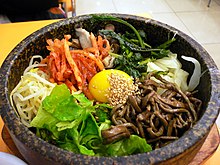
- Bibimbap (비빔밥, "mixed rice") - rice topped with vegetables, beef and egg, and served with a dollop of gochujang. A variation of this dish, dolsot bibimbap (돌솥 비빔밥), is served in a heated stone bowl, in which a raw egg is cooked against the sides of the bowl. Yukhoe (육회) is a popular version, comprising raw beef strips with raw egg and a dash of soy sauce mixed with Asian pear and gochujang. Everything (seasonings, rice and vegetables) is stirred together in one large bowl and eaten with a spoon.
- Hoedeopbap \hweh-dup-bahp\ (회덮밥) - rice topped with cubed raw fish, fresh vegetables and chogochujang.
Noodles

- Bibim guksu (비빔국수) - spicy cold wheat flour noodles; extremely popular during the summer season.
- Naengmyeon (냉면, (North Korea: 랭면, Raengmyŏn), "cold noodles") - this summer dish consists of several varieties of thin, hand-made buckwheat noodles, and is served in a large bowl with a tangy iced broth, raw julienned vegetables and fruit, and often a boiled egg and cold cooked beef. This is also called Mul ("water") Naengmyeon, to distinguish Bibim Naengmyeon, which has no broth and is mixed with gochujang.
- Jajangmyeon (짜장면) - a variation on a Chinese noodle dish that is extremely popular in Korea. It is made with a black bean sauce that is usually fried with ground pork or seafood and a variety of vegetables including zucchini and potatoes. Usually ordered and delivered, like pizza.
- Kalguksu (칼국수) - boiled flat noodles, usually in a broth made of anchovies and sliced zucchini.
- Ramyeon (라면) - a spicy variation of Japanese ramen, usually cooked with vegetables and meats.
Subsidiary dishes
Soups and stews



In Korean cuisine, depending on the amount of water and main ingredients, soup- and stew-type dishes are divided into three categories: guk (국) or tang (탕) for soups, and jjigae (찌개) and jeongol (전골) for stews. Guk and tang are commonly grouped together and regarded as the same type of dish, although guk is more watery and a basic dish for the Korean table setting and usually eaten at home. On the other hand, tang has less water than guk and has been developed to commercially sell in restaurants.
Jjigae and jeongol are both stew-like Korean dishes and usually served at a table to share with diners together. Jjigae is cooked in a kitchen but jeongol is cooked with a portable hot plate at the diner's table, and is a more elaborate type of stew.
- Guk (국), watery soup
- Tteokguk (떡국), tteok (rice cake) soup
- Haejangguk (해장국): a favorite hangover cure consisting usually of meaty pork spine, dried cabbage, coagulated ox blood (similar to blood pudding), and vegetables in a hearty beef broth. Legend has it that soon after World War II, the restaurant that invented this stew was the only place open in the Jongno district when the curfew at the time lifted at 4 a.m.
- Miyeok guk (미역국), wakame soup
- Tang (탕), thick soup
- Samgyetang (삼계탕): a soup made with Cornish game hens that are stuffed with ginseng, a hedysarum, sweet rice, jujubes, garlic, and chestnuts. The soup is traditionally eaten in the summer.
- Seolleongtang (설렁탕): ox leg bone soup simmered for more than 10 hours until the soup is milky-white. Usually served in a bowl containing glass noodles and pieces of beef. Sliced green onion and black pepper are used as condiments.
- Maeuntang (매운탕): a refreshing, hot and spicy fish soup.
- Gamjatang (감자탕, "pork spine stew"): a spicy soup made with pork spine, vegetables (especially potatoes) and hot peppers. The vertebrae are usually separated. This is often served as a late night snack but may also be served for a lunch or dinner.
- Jjigae (찌개), thick stew, formerly called "jochi" (조치) during the Joseon period
- Doenjang jjigae (된장찌개): or soybean paste soup, is typically served as the main course or served alongside a meat course. It contains a variety of vegetables, shellfish, tofu, and occasionally small mussels, shrimp, and/or large anchovies. Usually, anchovies are used for preparing the base stock, and are put out before adding main materials.
- Cheonggukjang jjigae (청국장찌개): a soup made from strong-smelling thick soybean paste containing whole beans
- Gochujang jjigae (고추장찌개): chili pepper paste soup
- Kimchi jjigae (김치찌개): A soup made with mainly kimchi, pork, and tofu. It is a common lunch meal or compliment to a meat course. It is normally served in a stone pot, still boiling when it arrives at the table.
- Sundubu jjigae (순두부찌개): a thick spicy stew made with soft tofu. Traditionally, the diner puts a raw egg in it while it is still boiling.
- Saeujeot jjige (새우젓찌개), jjigae made with saeujeot (fermented salted shrimp)
- Budae jjigae (부대찌개, "army squad stew"): Soon after the Korean War, meat was scarce in Seoul. Some people made use of surplus foods from US Army bases such as hot dogs and canned ham (such as Spam) and incorporated it into a traditional spicy soup. This budae jjigae is still popular in South Korea, and the dish often incorporates more modern ingredients such as instant ramen noodles.
- Saengseon jjige (생선찌개), fish stew
- Jeongol (전골) : elaborate stew consisting of various ingredients. It is generally served on a burner.
- Sinseollo, elaborate variety of jeongol once served in Korean royal court cuisine.
Banchan (side dishes)
Banchan (반찬) is a term collectively to refer to side dishes in Korean cuisine. Soups and stews are not considered as banchan.
Gui (grilled dishes)
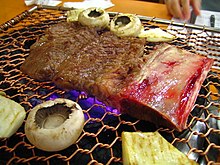

Gui are grilled dishes, which most commonly have meat or fish as their primary ingredient, but may in some cases also comprise grilled vegetables or other vegetarian ingredients. At traditional restaurants, meats are cooked at the center of the table over a charcoal grill, surrounded by various banchan and individual rice bowls. The cooked meat is then cut into small pieces and wrapped with fresh lettuce leaves, with rice, thinly sliced garlic, ssamjang (a mixture of gochujang and dwenjang), and other seasonings. The suffix gui is often omitted in the names of meat-based gui such as galbi, whose name is originally galbi gui.
- Bulgogi (불고기) - thinly sliced or shredded beef marinated in soy sauce, sesame oil, garlic, sugar, green onions, and black pepper, cooked on a grill (sometimes at the table). Bulgogi literally means "fire meat." Variations include pork (dweji bulgogi), chicken (dak bulgogi), or squid (ojingeo bulgogi).
- Galbi (갈비) - pork or beef ribs, cooked on a metal plate over charcoal in the centre of the table. The meat is sliced thicker than bulgogi. It is often called "Korean barbecue" along with bulgogi, and can be seasoned or unseasoned. A variation using seasoned chicken is called dak galbi.
- Samgyeopsal (삼겹살) - unseasoned pork bacon cut from the belly, served in the same fashion as galbi. Sometimes cooked on a grill with kimchi together at either side. Commonly grilled with garlic and onions, dipped in ssamjjang and wrapped in lettuce leaves.
- Makchang gui (막창구이) - grilled pork large intestines prepared like samgyeopsal and galbi, and often served with a light doenjang sauce and chopped scallions. It is very popular in Daegu and the surrounding Gyeongsang region.
- Gobchang gui (곱창구이) - similar to makchang except prepared from the small intestines of pork (or ox)
- Saengseon gui (생선구이) - grilled fish
- Seokhwa gui or jogae gui (석화구이 or 조개구이) - grilled shellfish
- Garibi gui (가리비구이)
- Deodeok gui (더덕구이) - grilled deodeok (Codonopsis lanceolata; 더덕)
- Beoseot gui (버섯구이) - grilled mushroom
- Gim gui or guun gim (김구이 or 구운 김) - grilled gim (laver)
Jjim and seon (steamed dishes)
Both jjim (찜) and seon (선) are generic terms referring to steamed or boiled dishes in Korean cuisine. However, the former is made with meat or seafood-based ingredients marinated in gochujang or ganjang sauce while seon is made with vegetable stuffed with fillings.
- Galbijjim (갈비찜), made by steaming marinated galbi (beef short rib) with diced potato and carrots in ganjang sauce
- Agujjim (아귀찜), made by steaming agui (blackmouth angler) and mideodeok (미더덕 styela clava), and kongnamul (soybean sprouts)
- Jeonbokjjim (전복찜), made with abalone and rice wine
- Oiseon (오이선), steamed stuffed cucumber
- Hobakseon (호박선), steamed stuffed zucchini
- Dubuseon (두부선), steamed tofu mixed with ground chicken and vegetables
Hoe (raw dishes)
Hoe (IPA: [hö] 회): although the term originally referred to any kind of raw dish, it is generally used to refer to saengseonhoe (생선회, raw fish dishes). It is dipped in gochujang, mustard sauce, or soy sauce with wasabi, and served with lettuce or perilla leaves (깻잎).
- Sannakji (산낙지) or live octopus. Sannakji is served live and still moving on the plate.
- Yukhoe (육회), similar to steak tartare
- Sukhoe (숙회), lightly parboiled hoe, usually made with squid or octopus.
- Ganghoe (강회), lightly parboiled hoe made with scallions or garlic chives
Jeon (savory pancakes)
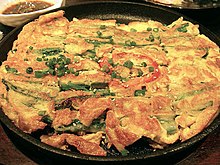
Jeon (or buchimgae) are savory pancakes made from various ingredients. Chopped kimchi or seafood is mixed into a wheat flour-based batter, and then fried in an oiled pan. This dish tastes best when it is dipped in a mixture of soy sauce, vinegar, and red pepper powder.
- Kimchijeon (김치전) - pancake made with kimchi, flour, and other vegetables.
- Pajeon (파전) - pancake made mostly with eggs, flour, green onion, and oysters or fresh baby clams. If a pajeon contains more seafood, it is called haemul pajeon (해물파전, literally "seafood pajeon")
- Bindaetteok (빈대떡) - pancake made of ground mung beans, scallions and kimchi or peppers.
Kimchi
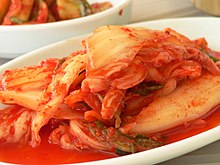
Kimchi (김치): vegetables (usually Napa cabbage, white radish, or cucumber) commonly fermented in a brine of ginger, garlic, green onion and chilli pepper. There are endless varieties, and it is served as a side dish or cooked into soups and rice dishes. Koreans traditionally make enough kimchi to last for the entire winter season, although with refrigerators and commercial jarred kimchi this practice has become less common.
Namul

Although the term namul may be used to refer to either saengchae and sukchae (fresh or heated vegetables), it generally indicates the latter.
- Saengchae (생채), made with shredded fresh vegetables and seasonings.
- Oisaengchae (오이생채) - marinated cucumber
- Doraji saengchae (도라지생채) - made with Chinese bellflower
- Sukchae (숙채), cooked vegetables
- Kongnamul (콩나물) - soybean sprouts, usually eaten in boiled and seasoned banchan. Soybean sprouts are also the main ingredient in kongnamul-bap (sprouts over rice), kongnamul-guk (sprout soup), and kongnamul-gukbap (rice in sprout soup).
- Japchae (잡채) - boiled sweet potato starch noodles (dangmyeon), steamed spinach, roasted julienned beef, roasted sliced onion, roasted julienned carrots are mixed with a seasoning made of soy sauce, sesame oil, and half-refined sugar.
Korean snacks
Snacks play an important social role in Korean culture. In Korea, snack food may be purchased from street carts during the day, where customers may eat standing beside the cart or have their food wrapped up to take home. At night, many streets are filled with small tents that sell inexpensive foods, drinks, and alcoholic beverages. Most Korean people consider the food sold there as snacks rather than a complete meal. Seasonal snacks include patbingsu, a refreshing iced treat eaten in the summer, and warm soup, gimbap, hotteok, and bungeoppang, which are enjoyed in the fall and winter.
Gimbap (literally, seaweed-rice, 김밥) consists of cooked rice, sesame oil, salt, and sesame seeds, to which small amounts of any vinegar and sugar are often added as seasonings. Then it is placed on a sheet of dried gim (laver). The seasoned rice is spread on the gim, and then fried egg, julienned carrots, julienned ham, seasoned ground beef or seasoned fish cakes, danmuji (sweet pickled daikon), seasoned spinach, and seasoned burdock root and cucumber are then placed closely together on the rice, and is rolled in the manner similar to that of the Japanese sushi. Today, there are many varieties of gimbap: tuna, cheese, bulgogi, vegetable, and more.

- Tteokbokki (떡볶이): a broiled dish which is made with sliced rice cake, seasoned beef, fish cakes, and vegetables. It is flavored with gochujang.
- Soondae (순대): Korean sausage made with a mixture of boiled sweet rice, oxen or pig's blood, potato noodle, mung bean sprouts, green onion and garlic stuffed in a natural casing.
- Hotteok (호떡) : similar to pancakes, but the syrup is in the filling rather than a condiment. Melted brown sugar, honey, chopped peanuts and cinnamon are common fillings. Vegetables are sometimes added to the batter. Hotteok is usually eaten during the winter months to "warm up" the body with the sweet and warm syrup in the pancake.
- Hobbang (호빵) : steamed bread
- Bungeoppang (붕어빵; "goldfish-bread") is a fish-shaped pastry that is usually filled with sweet red bean paste and then baked in a fish-shaped mold. It is very chewy on the inside and crispy on the outside. Gukwa-ppang (국화빵) is almost the same as bungeo-ppang, but it is shaped like a flower. Gyeran-ppang (계란빵) tastes similar to bungeo-ppang, but it has a shape of rounded rectangle. They are often sold by street vendors.
Anju (side dishes accompanying alcoholic beverages)
- Anju (안주) is a general term for a Korean side dish consumed with alcohol (often with Korean soju). It is commonly served at bars, noraebang (karaoke) establishments, and restaurants that serve alcohol. These side dishes can also be ordered as appetizers or even a main dish. Some examples of anju include steamed squid with gochujang, assorted fruit, dubu kimchi (tofu with kimchi), peanuts, odeng/ohmuk, sora (소라 (a kind of shellfish popular in street food tents), and nakji (small octopus). Soondae is also a kind of anju, as is samgyeopsal, or dwejigalbi. Most Korean foods may be served as anju, depending on availability and the diner's taste. However, anju are considered different from the banchan served with a regular Korean meal.
Desserts
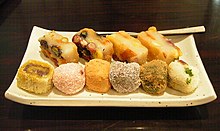
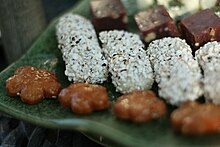
- Tteok (떡) - chewy rice cakes made from either pounded short-grain rice (메떡, metteok), pounded glutinous rice (찰떡, chaltteok), or glutinous rice left whole, without pounding (약식, yaksik). Is is served either cold (filled or covered with sweetened mung bean paste, red bean paste, raisins, a sweetened filling made with sesame seeds, mashed azuki beans, sweet pumpkin, beans, dates, pine nuts, and/or honey), usually served as dessert or snack. Sometimes cooked with thinly-sliced beef, onions, oyster mushrooms, etc., and served as a light meal.
- Songpyeon (송편) - chewy stuffed tteok (rice cake) served at Chuseok (Mid-Autumn Festival), and decorated with pine needles. Honey or another soft sweet material, or azuki beans, are used as fillings.
- Yaksik (약식) - a dessert made with glutinous rice chestnuts, pine nuts, jujubes, and raw sugar.
- Chapssaltteok (찹쌀떡) - a variety of tteok filled with sweet bean paste. Similar to Japanese mochi.
- Hangwa (한과) - general term referring to Korean traditional confectionery. The ingredients of hahngwa mainly consists of grain flour, honey, yeot, and sugar, or of fruit and edible root.
- Yugwa (유과) - made by frying and kneading like the literal meaning of the term.
- Maejakgwa (매작과) - ring-shaped confection made of wheat flour, vegetable oil, cinnamon, ginger juice, jocheong, and pine nuts.
- Suksilgwa (숙실과) - made by boiling fruits, ginger, or nuts in water and then reformed into the original fruit's shape, or other shapes.
- Gwapyeon (과편) - jelly-like confection made by boiling sour fruits, starch, and sugar.
- Dasik (다식), literally eatery for tea. It is made by kneading rice flour, honey, and various types of flour from nuts, herbs, sesame, or jujube.
- Jeonggwa (정과)
- Yeot gangjeong (엿강정)
- Yeot (엿) - a Korean traditional candy in liquid or solid form made from steamed normal rice, glutinous rice, glutinous kaoliang, corn, sweet potatoes or mixed grains. The steamed ingredients are lightly fermented and boiled in a large pot called sot (솥) for a long time.
- Yugwa (유과) - made by frying and kneading like the literal meaning of the term.
Korean beverages
Main article: List of Korean beveragesNon-alcoholic beverages
Main article: Korean teaAll Korean traditional non-alcoholic beverages are referred to as eumcheongnyu (음청류 飮淸類). According to historical documents regarding Korean cuisine, 193 items of eumcheongnyu are found. Eumcheongnyu can be divided into the following categories: cha (차 tea), tang (탕 boiled water), jang (장, fermented grain juice with sour taste), suksu (숙수), galsu (갈수, thirst water), hwachae (화채, fruit punch), sikhye (식혜, sweet rice drink), sujeonggwa (수정과, persimmon punch), milsu or kkulmul (밀수, 꿀물, honeyed water), jeup (즙, juice) and milk by their ingredient materials and preparation methods. Among the varieties of eumcheongnyu, cha, hwachae, sikhye, and sujeonggwa are still widely favored and consumed, however, tang, jang, suksu, galsu are almost disappeared in the present.

- Insam cha (인삼차) - Korean ginseng tea
- Saenggang cha (생강차) - Tea made from ginger root.
- Sujeonggwa (수정과) - dried persimmon punch
- Sikhye (식혜) - sweet rice beverage
- Yujacha (유자차) - citron tea
- Bori cha (보리차) - roasted barley tea
- Oksusu cha (옥수수차) - roasted corn tea
- Hyeonmi cha (현미차) - roasted brown rice tea
- Sungnyung (숭늉) - beverage made from boiled scorched rice
Alcoholic beverages
Main article: Korean wine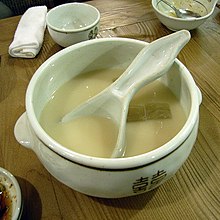
While soju (소주) is the best known liquor, there are well over 100 different beers, wines and liquors available in Korea. The top-selling domestic beers are lagers, similar to others found in Europe and Asia. These include:
- Cass
- Hite, Hite Prime, Hite Prime Max
- Cafri
- OB lager beer which adds rice to the grain base, and is also available as a dry beer.
- Taedonggang (대동강) is a North Korean beer which is now sold bottled in some bars in South Korea.
- Microbrewery beers and bars are growing in popularity.
Soju is a clear spirit which was originally made from grain, and is now also made from sweet potatoes. Soju made from grain is considered superior (as is also the case with grain vs. potato vodka). Soju is around 22% ABV and is a favorite beverage of hard-up college students, hard-drinking businessmen, and blue-collar workers.
Yakju is a refined pure liquor fermented from rice, with the best known being cheongju. Takju is a thick unrefined liquor made with grains, with the best known being makkoli (막걸리), a white, milky rice wine traditionally drunk by farmers.
Korean wines are generally divided into fruit wines, and herbal wines. Acacia, maesil plum, Chinese quince, cherry, pine fruits, and pomegranate are most popular. Majuang wine (a blended wine of Korean grapes with French or American wines) and ginseng-based wines are also available.
Juansang - Alcoholic drinks (ju) and accompanying side dishes (an) are set on the table. The dishes vary depending on the kinds of liquor or wine.
Gyojasang is a large table prepared for banquets. Alcohol beverages and a large variety of side dishes, rice cakes, confectionaries, and fruit punch are all placed on the table. After the liquor is finished, noodle soup is served.
Contemporary innovations
Fusion food is also rapidly becoming popular. There are many Chinese, northern Italian, French, and Indian fusion restaurants all over South Korea.
Vegetarian restaurants, which were sidelined with the decline of Buddhism and advance of missionary Christianity, have had a small resurgence, and can usually be found in every city.
Korean restaurants abroad
Korean restaurants are usually available in areas with large Korean populations. Common examples include Koreatowns situated in other countries.
Restaurants run by the North Korean government have opened in China, Mongolia, Cambodia, Thailand, and Vietnam.
Dog meat consumption
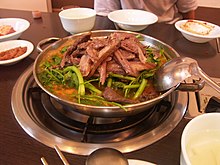
Numerous animals have been consumed in the history of Korean cuisine, while some are common in other parts of the world, others such as dog meat have become part of the cuisine as well. Dogs have been consumed in Korea dating back to antiquity. The dogs raised for meat, the nureongee (누렁이) breed, differ from those raised for pets which Koreans may keep in their homes.
Dog meat is usually consumed during the summer months and is either roasted or prepared in soups. The most popular of these soups is kaejang-guk, a spicy stew meant to balance the bodies heat during the summer months, this is thought to ensure good health by balancing one's "ki" or vital energy of the body. A 19th century version of kaejang-guk explains the preparation of the dish by boiling dog meat with green onions and chili powder. Variations of the dish contain chicken and bamboo shoots. The dish is still popular in contemporary Korea during the summer months.
In 1988, during the Summer Olympic games, the government of South Korea closed all restaurants serving kaejang-guk to better improve the countries image to western culture visitors. Brigitte Bardot, a prominent head of a French animal rights organization which is named after her, launched a crusade during the 2002 FIFA World Cup in Seoul, Korea, to have dog meat outlawed in Korea. She promoted people to boycott the games in the government did not outlaw the sale of dog meat in restaurants in Seoul. This concept seemed out of place to those people in Southern China, Southeast Asia and parts of Latin America where dog meat is seen as an affordable meat source, especially in China where records of dog consumption date back to 500 B.C. where recipes of dog dishes were listed in the Li Ji for ritual consumption. In 1995 organizers of the largest dog show in England decided to not accept the sponsorship of Samsung, the Korean based electronics company when the International Fund for Animal Welfare claimed that two million dogs were processed for food in Korea annually.
As of 2003, approximately 4,000-6,000 restaurants served soups made from dog meat in Korea. The soups cost about US$10 while dishes of steamed dog meat with rice cost about US$25. Although technically illegal to sell dog meat in Korea, restaurateurs still do so even though they risk losing their restaurant licenses. In 1997 one dog meat wholesaler in Seoul was brought up on charges of selling dog meat illegally, but was later acquitted by the court which ruled that dog meat was a socially accepted food.
Sometimes the dogs killed for consumption are first tortured, in order to increase the "fight" or adrenaline in the meat. A dog that dies painfully is believed to have softer meat, and impart the energy of its death to the consumer. Methods of inflicting painful death include slow hanging and beating.
Notes
- Fritscher, Lisa. "Korean Food Basics: What You Might Find On A Korean Food Menu". LifeScript.com. Retrieved 2007-11-17.
{{cite web}}: More than one of|author=and|last=specified (help) - Pettid, 12.
- Pettid, 13.
- Pettid, 13.
- Pettid, 13-14.
- Pettid, 15.
- Pettid, 16.
- "King Sejong's Humanism". National Assembly of the Republic of Korea. Retrieved 2008-06-10.
Believing that farmers could benefit from more practical knowledge of agriculture, he commissioned Jeong Cho to compile the Nongsa jikseol (Straight Talk on Farming), a volume replete with information on plowing, seed preparation and planting, which the author learned first-hand from elderly peasants throughout the country. The first such book in Korea, it became the classic work on the subject of Korean agriculture.
- Pettid, 17.
- "농사직설(農事直說), Nongsa jikseol" (in Korean / English). The Academy of Korean Studies. Retrieved 2008-06-10.
{{cite web}}: CS1 maint: unrecognized language (link) - Pettid, 18.
- Pettid, 18-19.
- Pettid, 19.
- Pettid, 163.
- Pettid, 19-20.
- Pettid, 29,163.
- Pettid, 20.
- Pettid, 19-20.
- Pettid, 164-165.
- Pettid, 166.
- 최용기 (2008-02-25). "Guk and Tang ('국'과 '탕')" (in Korean). Official site of the Seoul Metropolitan Government. Retrieved 2008-05-26.
- 엠파스 백과사전
- 백운화 (April, 1996). "제 3 주제 전통 음청류의 산업화 현황과 전망" (in Korean). 인제식품과학 FORUM: pp. 75~95.
{{cite journal}}:|pages=has extra text (help); Check date values in:|date=(help); Cite journal requires|journal=(help) - "Introduction of Eumcheongryu". Korea Agro-Fisheries Trade Corporation. Retrieved 2008-05-22.
- 손경희 (April, 1996). "제 1 주제 한국 전통 음청류의 역사적 고찰" (in Korean). 인제식품과학 FORUM: pp. pp. 7~23.
{{cite journal}}:|pages=has extra text (help); Check date values in:|date=(help); Cite journal requires|journal=(help) - Pettid, 25, 84-85
- Pettid, 84-85
- Hopkins, 19-22
- Hopkins, 23.
- BBC News Dogs blow-torched alive
- Korean Animal Protection Society Video of Dog Markets and Dog slaughter from SBS News Seven
- International Aid for Korean Animals Video Clips
- In Defense of Animals, video from Animal Freedom Korea. Undercover Video
References
- Cost, Bruce. Asian ingredients: a guide to the foodstuffs of China, Japan, Korea, Thailand, and Vietnam. New York: Harper Perennial, 2000. ISBN 0-06-093204-X
- Hopkins, Jerry. Extreme Cuisine: The Weird & Wonderful Foods that People Eat, Signapore: Tuttle Publishing, 2004.
- O'Brien, Betsy. Let's Eat Korean Food. Elizabeth, NJ:Hollym, 1997. ISBN 1-56591-071-0
- Pettid, Michael J., Korean Cuisine: An Illustrated History, London: Reaktion Books Ltd., 2008.
See also
External links
- Food in Korea at the Korea Agro-Fisheries Trade Corporation
- Korean Food Recipe and Pictures at trifood.com
- Official site of Korea National Tourism List of Korean Food
- Eating the Korean way at the Cultural Profiles Project (Canada)
- Template:Ko List of articles about Korean cuisine at the Doosan Encyclopedia
- Template:Ko Categories of Korean cuisine at the Empas / EncyKorea
Korean Restaurant links
- US & Canada Korean Restaurant Directories
- US Korean Restaurant Guide
- Europe Korean Directoy - Find Korea close to you!
| Cuisine of Asia | |
|---|---|
| Sovereign states |
|
| States with limited recognition | |
| Dependencies and other territories | |